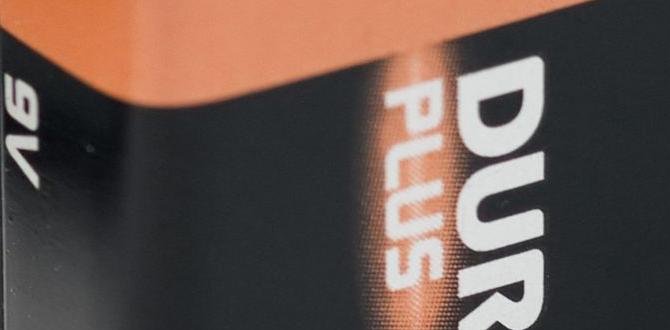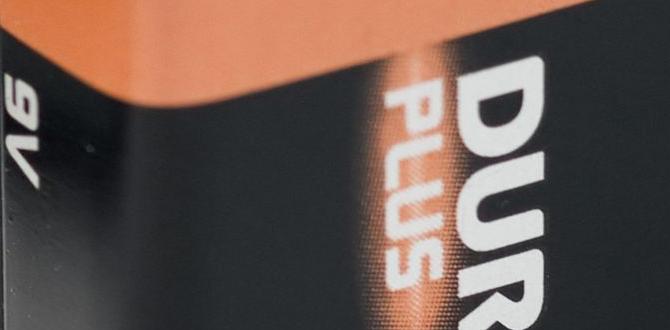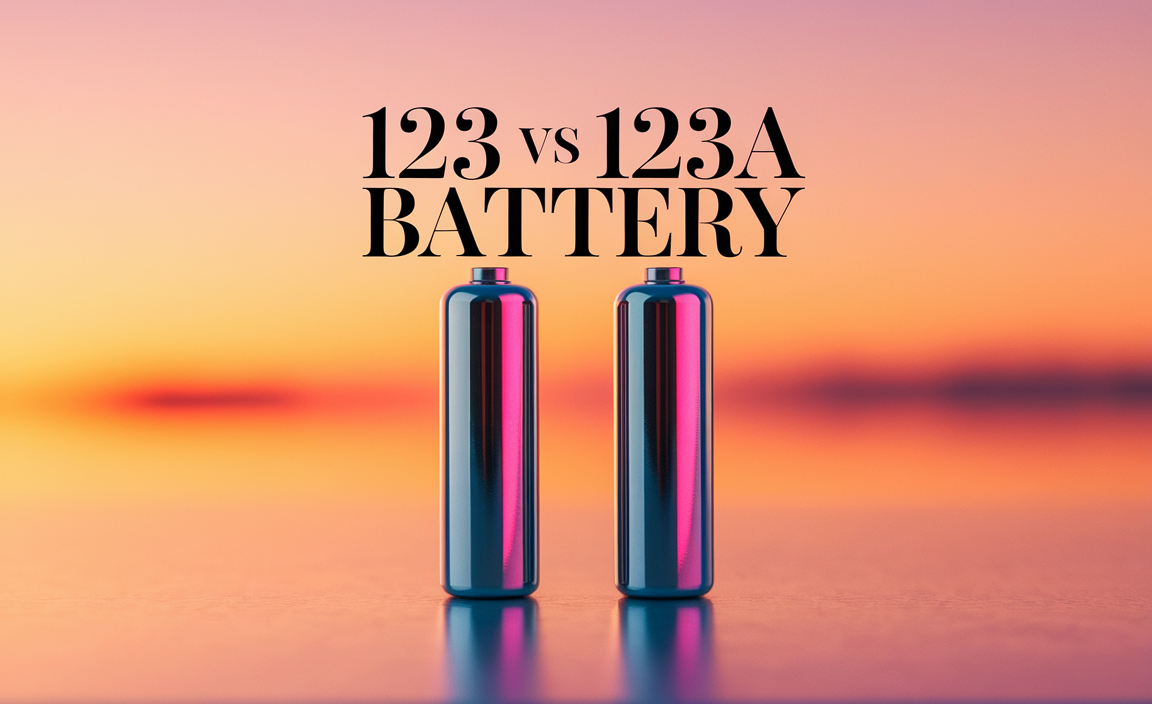Ryobi 12V Replacement Battery: Get Your Tools Back in Action! Find the right power source to keep your Ryobi 12V tools running strong. Learn how to pick the best battery, what to look for, and simple tips to make them last.
Is your favorite Ryobi 12V tool suddenly slowing down or refusing to start? That’s a common frustration, and it often points to a battery that’s lost its charge. Don’t let a drained battery sideline your projects! Finding the correct replacement battery for your Ryobi 12V tools is simpler than you think. We’ll walk you through everything you need to know to get the perfect fit and keep your tools performing their best. Get ready to power up your productivity again!
Why Your Ryobi 12V Battery Needs Replacing
Like all rechargeable batteries, the ones in your Ryobi 12V tools don’t last forever. Over time, the chemical reactions inside them that store and release energy start to wear out. This means they hold less charge, take longer to charge, and eventually just can’t power your tools effectively anymore.
Several factors can affect how long a battery lasts:
- Charge Cycles: Every time you charge and discharge the battery, it uses up a tiny bit of its lifespan.
- Heat and Cold: Extreme temperatures, both hot and cold, can damage the battery’s internal components and reduce its capacity.
- Deep Discharges: Letting the battery drain completely (to zero power) too often can stress it out.
- Storage: Storing a battery with a very low or very full charge for long periods isn’t ideal.
When you start noticing these signs, it’s time to think about a replacement. A fresh battery will bring back the zippy performance you remember and make your DIY tasks much easier.
Understanding Ryobi 12V Battery Types
Ryobi has produced a few different generations of 12V tools and batteries, which can sometimes cause confusion when looking for a replacement. The most common types you’ll encounter are:
NiCd (Nickel-Cadmium) Batteries
These were some of Ryobi’s earlier 12V batteries. They are heavier and can suffer from “memory effect,” meaning if you recharge them before they’re fully drained, they might lose some of their maximum capacity over time. While still functional, they are largely being phased out in favor of newer technologies.
Li-ion (Lithium-ion) Batteries
Modern Ryobi 12V tools almost exclusively use Li-ion batteries. These are lighter, hold their charge longer when not in use, and don’t suffer from the memory effect. They are the standard for most new Ryobi 12V power tools.
It’s important to match your replacement battery to the type of battery your tool was originally designed for. While some chargers are multi-chemistry, using the wrong battery type with a charger can be inefficient or even unsafe.
How to Find the Right Replacement Battery for Your Ryobi 12V Tool
Finding the correct replacement battery is key to ensuring your tools run properly and safely. Here’s a breakdown of what to look for.
1. Identify Your Tool Model
The first step is to find out exactly which Ryobi 12V tool you have. Look for the model number on the tool itself. It’s usually on a sticker or plate on the body of the tool.
For example, you might have a “Ryobi HJP101 Drill” or a “Ryobi CSL120 Screwdriver.” Knowing this specific model helps you search for compatible batteries.
2. Check Your Original Battery
Your existing battery is a treasure trove of information!
- Voltage: It will clearly state “12V.” This is non-negotiable – you must use a 12V battery with a 12V tool.
- Battery Chemistry: Look for “NiCd” or “Li-ion.”
- Amperage-hour (Ah): This tells you how much power the battery holds. Common ratings for 12V batteries are around 1.3Ah, 1.5Ah, or 2.0Ah. Higher Ah means longer run time.
- Battery Part Number: Often, there’s a specific part number for the battery itself. This is the most direct way to find an exact replacement. It might look something like “130481001” for a Ryobi battery.
Take a clear photo of your old battery with all this information visible. This will be incredibly helpful when shopping online or in a store.
Where to Buy Replacement Ryobi 12V Batteries
You have a few options when it comes to purchasing a new battery:
Official Ryobi Retailers
The most straightforward option is to buy directly from Ryobi or authorized dealers. This guarantees you’re getting a genuine Ryobi battery, which is built to the exact specifications of your tools.
- Ryobi’s Official Website: Often they have replacement parts available.
- Home Improvement Stores: Big box stores like The Home Depot (which is a primary Ryobi retailer) are excellent places to find genuine Ryobi batteries.
Third-Party Battery Manufacturers
You’ll find many companies online that make “compatible” or “aftermarket” replacement batteries for Ryobi tools. These can sometimes be less expensive.
Pros:
- Often more affordable.
- Wider selection might be available if genuine parts are scarce for older models.
Cons:
- Quality can vary significantly. Some are excellent, others are poor.
- They might not perform as well as genuine batteries (less run time, slower power delivery).
- There’s a small risk of compatibility issues or safety concerns if not manufactured to strict standards.
When choosing a third-party battery:
- Read customer reviews diligently.
- Check the warranty offered.
- Ensure it explicitly states compatibility with your specific Ryobi 12V tool and battery type (NiCd or Li-ion).
Online Marketplaces
Sites like Amazon, eBay, and others list both genuine and third-party batteries. Be extra cautious here. Always check the seller’s reputation and read product descriptions very carefully to ensure you’re getting what you expect.
Comparing Battery Specifications
When you’re looking at replacement batteries, you’ll see a few key specs that matter:
Voltage (V)
This is the electrical “pressure” the battery provides. For Ryobi 12V tools, you must get a 12-volt battery. Using a battery with a different voltage can damage your tool or the battery itself.
Amperage-hour (Ah)
This indicates the battery’s capacity – essentially, how long it can provide power. A higher Ah rating means longer run time on a single charge. For example, a 2.0Ah battery will run twice as long as a 1.0Ah battery under the same load.
You can often use a higher Ah battery than your original if it’s the correct voltage and chemistry for your tool. This is a great way to get more work done between charges!
Battery Chemistry (NiCd vs. Li-ion)
As mentioned, Li-ion is the modern standard. If your tool came with a Li-ion battery, stick with Li-ion replacements. If you have an older NiCd tool, you generally need a NiCd battery. While some newer chargers can handle both, it’s safest to use the chemistry your tool was designed for or check compatibility carefully.
Compatibility List
Reputable sellers will provide a list of Ryobi tool models or battery part numbers that their replacement battery is compatible with. Make sure your tool or old battery part number is on this list.
Understanding Battery Chargers
A new battery is only half the equation; you also need a compatible charger!
Ryobi has made several 12V battery chargers over the years. Most 12V Li-ion chargers are able to charge different Ah ratings of Li-ion batteries from the same voltage family (e.g., a charger for 12V 1.3Ah Li-ion can charge 12V 2.0Ah Li-ion batteries).
Important Considerations:
- Chemistry Specific: Some older Ryobi chargers were designed only for NiCd batteries and will not charge Li-ion, and vice-versa.
- Voltage Specific: You need a charger designed for 12V batteries. Don’t try to charge a 12V battery with an 18V charger or vice-versa.
- Condition of Your Old Charger: If your old charger has been sitting around for a long time, it’s worth checking if it’s still working correctly before investing in a new battery. Sometimes, a faulty charger can damage a new battery.
If you’ve lost your charger or suspect it’s not working well, it’s a good idea to get a new one that is guaranteed to be compatible with your new battery and tool voltage. For example, Ryobi’s One+ 12V Lithium-ion Charger is designed for their 12V Li-ion batteries.
Replacing the Battery: A Step-by-Step Guide (It’s Easy!)
Swapping out a Ryobi 12V battery is usually incredibly simple. Most Ryobi tools are designed for quick battery changes.
What You’ll Need
- Your new Ryobi 12V replacement battery.
- Your Ryobi 12V tool.
That’s it! No special tools are typically required.
The Simple Process
- Ensure the Tool is Off: Make sure your tool is not accidentally switched on and that the trigger is not engaged.
- Locate the Battery Release Latch: On the bottom or back of the tool handle, where the battery attaches, you’ll see one or two plastic latches or buttons.
- Press the Latch/Button: Press and hold down on these latches. This disengages the battery from the tool.
- Slide Out the Old Battery: While holding the latch(es), gently slide the old battery pack away from the tool. It should come out smoothly.
- Align the New Battery: Take your new replacement battery and align the guide rails on the battery with the corresponding slots on the tool.
- Slide In the New Battery: Push the new battery firmly into the tool until it clicks into place. You should hear or feel a distinct “snap” when it’s fully seated.
- Test It Out: Gently pull on the battery to ensure it’s secured. Then, try operating your tool briefly to confirm it’s working with the new power source.
It really is that easy! You’ve just given your tool a new lease on life.
Battery Care Tips for Maximum Lifespan
Once you have your new battery, you’ll want to take good care of it so it lasts as long as possible. Here are some practical tips:
Charge Smart
- Avoid Overcharging: Modern Li-ion batteries have built-in protection to prevent overcharging when left on the charger. However, it’s still good practice to remove the battery once it’s fully charged.
- Charge Before Storage: If you plan to store the battery for an extended period (more than a few weeks), charge it to about 50-70% first. Don’t store it completely dead or completely full.
- Use the Right Charger: Always use the charger specifically designed for your battery type and voltage (e.g., a Ryobi 12V Li-ion charger for a 12V Li-ion battery).
Temperature Control
- Avoid Extreme Heat: Never leave batteries in a hot car, direct sunlight, or near heat sources. High heat is a battery killer.
- Avoid Extreme Cold: Very cold temperatures can temporarily reduce battery performance. If a battery has been very cold, let it warm up to room temperature before charging.
Usage Habits
- Avoid Deep Discharges: Try not to let the battery run completely flat every single time. If you notice your tool slowing down significantly, it’s a good time to recharge.
- Keep Contacts Clean: Occasionally, wipe the metal battery contacts on both the battery and the tool with a dry, lint-free cloth. This ensures good electrical connection for optimal power transfer.
Storage
- Store in a Cool, Dry Place: When not in use, store batteries in a place that’s neither too hot nor too cold.
- Use Original Packaging or Case: If possible, store batteries in their original packaging or a dedicated battery case to protect them from dust and damage.
By following these simple care tips, you can significantly extend the life and performance of your new Ryobi 12V battery.
Troubleshooting Common Battery Issues
Sometimes, even with a new battery, you might run into a problem. Here are a few common issues and how to fix them:
Problem: New Battery Doesn’t Fit
Cause: Incorrect model or voltage. The battery might be designed for a different Ryobi series (e.g., 18V) or a different tool that uses a similar-looking battery.
Solution: Double-check the voltage and model number of both your tool and the battery you purchased. Ensure it’s specifically listed as compatible with your Ryobi 12V tool. Return the incorrect battery and get the right one.
Problem: New Battery Won’t Charge
Cause 1: Faulty charger or incompatible charger.
Solution 1: Try charging your old battery (if it still holds a little charge) with the new charger, or try charging the new battery with a known working compatible charger. Ensure the charger is correct for the battery’s chemistry (Li-ion vs. NiCd) and voltage (12V).
Cause 2: Battery contacts are dirty.
Solution 2: Clean the metal contacts on the battery and the charger with a dry, lint-free cloth and try again. You can also use a pencil eraser gently on the contacts for a better clean.
Cause 3: Battery is damaged or defective.
Solution 3: If the battery is brand new and won’t charge with a correct, working charger, it might be defective. Contact the seller or manufacturer for a replacement under warranty.
Problem: New Battery Dies Very Quickly
Cause 1: Higher Ah rating means more power, but if it’s significantly higher, sometimes tools can draw more current than expected, or the battery wasn’t fully charged.
Solution 1: Ensure the battery was fully charged according to the charger’s indicators. If you purchased a significantly higher Ah battery (to get more run time), but it still dies quickly on demanding tasks, ensure your tool is performing as expected. Sometimes a tool issue can drain a battery faster.
Cause 2: Defective battery, even if new.
Solution 2: If the battery dies considerably faster than your old one did when it was new, and you’ve followed all charging and usage tips, it’s possible the battery isn’t performing to spec. Contact the seller for possible exchange.
Cause 3: Tool issue causing excessive power drain.
Solution 3: This is less common, but if multiple new batteries drain exceptionally fast, there might be an issue with the tool itself (e.g., a struggling motor). Consult Ryobi support or a repair professional if you suspect this.
Problem: Tool Runs Weakly Even with a New Battery
Cause: This could be a sign that the tool itself is experiencing issues. Motors can wear out, or internal components can fail, leading to reduced power output even with a fully charged, healthy battery.
Solution: Test the new battery/tool combination with a variety of tasks. If the weakness is consistent across all operations, consider contacting Ryobi service or a tool repair specialist. It might be more cost-effective to replace the tool rather than repair it, especially for older 12V models.
Always keep your paperwork and receipts for new batteries and chargers in case you need to utilize their warranty.
Battery Specifications Comparison Table
To help you visualize the most important factors when choosing a replacement battery, here’




